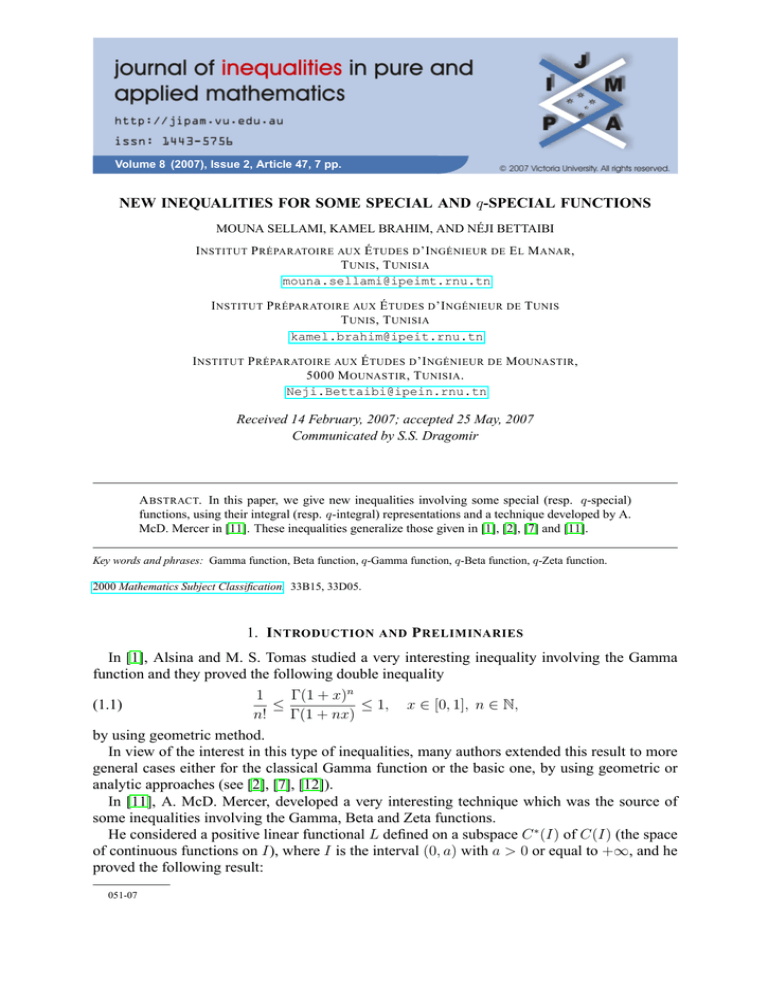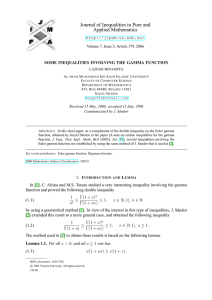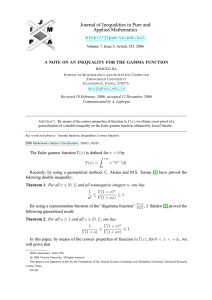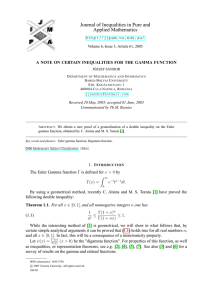NEW INEQUALITIES FOR SOME SPECIAL AND I P
advertisement

Volume 8 (2007), Issue 2, Article 47, 7 pp.
NEW INEQUALITIES FOR SOME SPECIAL AND q-SPECIAL FUNCTIONS
MOUNA SELLAMI, KAMEL BRAHIM, AND NÉJI BETTAIBI
I NSTITUT P RÉPARATOIRE AUX É TUDES D ’I NGÉNIEUR DE E L M ANAR ,
T UNIS , T UNISIA
mouna.sellami@ipeimt.rnu.tn
I NSTITUT P RÉPARATOIRE AUX É TUDES D ’I NGÉNIEUR DE T UNIS
T UNIS , T UNISIA
kamel.brahim@ipeit.rnu.tn
I NSTITUT P RÉPARATOIRE AUX É TUDES D ’I NGÉNIEUR DE M OUNASTIR ,
5000 M OUNASTIR , T UNISIA .
Neji.Bettaibi@ipein.rnu.tn
Received 14 February, 2007; accepted 25 May, 2007
Communicated by S.S. Dragomir
A BSTRACT. In this paper, we give new inequalities involving some special (resp. q-special)
functions, using their integral (resp. q-integral) representations and a technique developed by A.
McD. Mercer in [11]. These inequalities generalize those given in [1], [2], [7] and [11].
Key words and phrases: Gamma function, Beta function, q-Gamma function, q-Beta function, q-Zeta function.
2000 Mathematics Subject Classification. 33B15, 33D05.
1. I NTRODUCTION AND P RELIMINARIES
In [1], Alsina and M. S. Tomas studied a very interesting inequality involving the Gamma
function and they proved the following double inequality
1
Γ(1 + x)n
≤
≤ 1, x ∈ [0, 1], n ∈ N,
n!
Γ(1 + nx)
by using geometric method.
In view of the interest in this type of inequalities, many authors extended this result to more
general cases either for the classical Gamma function or the basic one, by using geometric or
analytic approaches (see [2], [7], [12]).
In [11], A. McD. Mercer, developed a very interesting technique which was the source of
some inequalities involving the Gamma, Beta and Zeta functions.
He considered a positive linear functional L defined on a subspace C ∗ (I) of C(I) (the space
of continuous functions on I), where I is the interval (0, a) with a > 0 or equal to +∞, and he
proved the following result:
(1.1)
051-07
2
M. S ELLAMI , K. B RAHIM , AND N. B ETTAIBI
Theorem 1.1. For f, g in C ∗ (I) such that f (x) → 0, g(x) → 0 as x → 0+ and fg is strictly
increasing, put
L(f )
φ=g
L(g)
and let F be defined on the ranges of f and g such that the compositions F (f ) and F (g) each
belong to C ∗ (I).
a) If F is convex then
L [F (f )] ≥ L [F (φ)] .
(1.2)
b) If F is concave then
L [F (f )] ≤ L [F (φ)] .
(1.3)
In this paper, using the previous theorem, we obtain some generalizations of inequalities
involving some special and q-special functions.
Note that for α ∈ R, the function
F (t) = tα
is convex if α < 0 or α > 1 and concave if 0 < α < 1.
So, for f and g satisfying the conditions of the previous theorem, we have:
L(f α ) > L(φα ) if α < 0 or α > 1 and L(f α ) < L(φα ) if
0 < α < 1.
Substituting for φ this reads:
[L(g)]α
[L(f )]α
>
(resp.
<)
,
L(g α )
L(f α )
if α < 0 or α > 1 (resp. 0 < α < 1). In particular, if we take f (x) = xβ and g(x) = xδ with
β > δ > 0, we obtain the following useful inequality:
[L(xδ )]α
[L(xβ )]α
≷
,
L(xαδ )
L(xαβ )
where, we follow the notations of [11], and ≷ correspond to the case (α < 0 or α > 1) and (
0 < α < 1) respectively.
Throughout this paper, we will fix q ∈]0, 1[ and we will follow the terminology and notation
of the book by G. Gasper and M. Rahman [4]. We denote, in particular, for a ∈ C
(1.4)
n−1
Y
1 − qa
[a]q =
, (a; q)n =
(1 − aq k ), n = 1, 2, . . . , ∞.
1−q
k=0
The q-Jackson integrals from 0 to a and from 0 to ∞ are defined by (see [5])
Z a
∞
X
(1.5)
f (x)dq x = (1 − q)a
f (aq n )q n ,
0
Z
n=0
∞
f (x)dq x = (1 − q)
(1.6)
0
∞
X
f (q n )q n ,
n=−∞
provided the sums converge absolutely.
The q-Jackson integral in a generic interval [a, b] is given by (see [5])
Z b
Z b
Z a
(1.7)
f (x)dq x =
f (x)dq x −
f (x)dq x.
a
J. Inequal. Pure and Appl. Math., 8(2) (2007), Art. 47, 7 pp.
0
0
http://jipam.vu.edu.au/
N EW I NEQUALITIES FOR S OME S PECIAL AND q-S PECIAL F UNCTIONS
3
2. T HE G AMMA F UNCTION
Theorem 2.1. Let f be the function defined by
(2n)
α
Γ (1 + x)
(2.1)
f (x) = (2n)
Γ (1 + αx)
then for all 0 < α < 1 (resp. α > 1) f is increasing (resp. decreasing) on (0, ∞).
Proof. First, we recall that the Gamma function is infinitely differentiable on ]0, +∞[ and we
have
Z ∞
(n)
∀x ∈]0, +∞[, ∀n ∈ N, Γ (x) =
tx−1 [Log(t)]n e−t dt.
0
Now, we consider the subspace C ∗ (I) obtained from C(I) by requiring its members to satisfy:
(i) w(x) = O(xθ ) (for any θ > −1) as x → 0,
(ii) w(x) = O(xϕ ) (for any finite ϕ) as x → +∞.
For w ∈ C ∗ (I), we define
Z ∞
(2.2)
L(w) =
w(x)(Log(x))2n e−x dx.
0
The linear functional L is well-defined on C ∗ (I) and it is positive.
Then, by applying the inequality (1.4), we obtain for β > δ > 0,
(2n)
α
(2n)
α
Γ (1 + β)
Γ (1 + δ)
(2.3)
≷ (2n)
.
Γ(2n) (1 + αδ)
Γ (1 + αβ)
This completes the proof.
In particular, we have the following result, which generalizes inequality (4.1) of [11].
Corollary 2.2. For all x ∈ [0, 1] we have:
(2n) α
(2n)
α
α−1
Γ (2)
Γ (1 + x)
≤ (2n)
≤ Γ(2n) (1)
(2.4)
(2n)
Γ (1 + α)
Γ (1 + αx)
if
α≥1
and
(2.5)
(2n)
α
(2n) α
(2n) α−1
Γ (1 + x)
Γ (2)
Γ (1)
≤ (2n)
≤ (2n)
Γ (1 + αx)
Γ (1 + α)
if
0 < α ≤ 1.
Taking n = 0, one obtains:
Corollary 2.3. For all x ∈ [0, 1],
(2.6)
1
[Γ(1 + x)]α
≤
≤ 1,
Γ(1 + α)
Γ(1 + αx)
if
α ≥ 1,
and
(2.7)
[Γ(1 + x)]α
1
1≤
≤
,
Γ(1 + αx)
Γ(1 + α)
J. Inequal. Pure and Appl. Math., 8(2) (2007), Art. 47, 7 pp.
if
0 < α ≤ 1.
http://jipam.vu.edu.au/
4
M. S ELLAMI , K. B RAHIM , AND N. B ETTAIBI
3. T HE q-G AMMA F UNCTION
Jackson [5] defined a q-analogue of the Gamma function by
Γq (x) =
(3.1)
(q; q)∞
(1 − q)1−x ,
(q x ; q)∞
x 6= 0, −1, −2, . . . .
It is well known that it satisfies
(3.2)
Γq (x + 1) = [x]q Γq (x),
Γq (1) = 1 and
lim Γq (x) = Γ(x), <(x) > 0.
q→1−
It has the following q-integral representation (see [8])
Z 1
1−q
(3.3)
Γq (s) =
ts−1 Eq−qt dq t,
0
where
(3.4)
Eqz
=0 ϕ0 (−; −; q, −(1 − q)z) =
∞
X
q
n(n−1)
2
n=0
(1 − q)n n
z = (−(1 − q)z; q)∞ ,
(q; q)n
is a q-analogue of the exponential function (see [4] and [6]).
In [3], the authors proved that Γq is infinitely differentiable on ]0, +∞[ and we have
Z 1
1−q
(n)
(3.5)
∀x ∈]0, +∞[, ∀n ∈ N, Γq (x) =
tx−1 [Log(t)]n Eq−qt dt.
0
Now, we are able to state a q-analogue of Theorem 2.1, and give generalizations of some
inequalities studied in [7].
Theorem 3.1. Let f be the function defined by
h
iα
(2n)
Γq (1 + x)
(3.6)
f (x) = (2n)
Γq (1 + αx)
then for all 0 < α < 1 (resp. α > 1) f is increasing (resp. decreasing) on (0, ∞).
1
Proof. We consider I = 0, 1−q and the subspace C ∗ (I) obtained from C(I) by requiring its
members to satisfy:
(i) w(x) = O(xθ ) (for any θ > −1) as x → 0,
1
.
(ii) w(x) = O(1) as x → 1−q
∗
For w ∈ C (I), we define
Z 1
1−q
(3.7)
L(w) =
w(x)(Log(x))2n Eq−qx dq x.
0
L is well-defined on C ∗ (I) and it is a positive linear functional on C ∗ (I).
From the inequality (1.4) and the relation (3.5), we obtain for β > δ > 0
h
iα
h
iα
(2n)
(2n)
Γq (1 + δ)
Γq (1 + β)
(3.8)
≷ (2n)
,
(2n)
Γq (1 + αδ)
Γq (1 + αβ)
which achieves the proof.
In particular, we have the following result.
J. Inequal. Pure and Appl. Math., 8(2) (2007), Art. 47, 7 pp.
http://jipam.vu.edu.au/
N EW I NEQUALITIES FOR S OME S PECIAL AND q-S PECIAL F UNCTIONS
5
Corollary 3.2. For all x ∈ [0, 1] we have
h
iα
h
iα
(2n)
(2n)
Γq (1 + x)
Γq (2)
α−1
(3.9)
≤ (2n)
≤ Γ(2n)
(1)
, if α ≥ 1
q
(2n)
Γq (1 + α)
Γq (1 + αx)
and
h
iα
h
iα
(2n)
(2n)
Γ
(2)
Γ
(1
+
x)
q
q
(2n) α−1
(3.10)
Γq (1)
≤ (2n)
≤ (2n)
, if 0 < α ≤ 1.
Γq (1 + αx)
Γq (1 + α)
Corollary 3.3. For all x ∈ [0, 1],
(3.11)
1
[Γq (1 + x)]α
≤
≤ 1,
Γq (1 + α)
Γq (1 + αx)
α ≥ 1,
if
and
(3.12)
1≤
1
[Γq (1 + x)]α
≤
,
Γq (1 + αx)
Γq (1 + α)
if
0 < α ≤ 1.
Proof. By taking n = 0 in Corollary 3.2 we obtain the inequalities (3.11) and (3.12).
4. T HE q-B ETA
FUNCTION
The q-Beta function is defined by (see [4], [8])
Z 1
(xq; q)∞
(4.1)
Bq (t, s) =
xt−1
dq x,
<(s) > 0, <(t) > 0
(xq s ; q)∞
0
and we have
Γq (t)Γq (s)
(4.2)
Bq (t, s) =
.
Γq (t + s)
Since Bq is a q-analogue of the classical Beta function, we can see the following results as
generalizations of those given in [11].
Theorem 4.1. For s > 0, let f be the function defined by
[Bq (1 + x, s)]α
(4.3)
f (x) =
.
Bq (1 + αx, s)
If 0 < α < 1, f is increasing on [0, +∞[.
If α > 1 f is decreasing on [0, +∞[.
Proof. We consider the interval I = (0, 1) and the subspace C ∗ (I) obtained from C(I) by
requiring its members to satisfy:
(i) w(x) = O(xθ ) (for any θ > −1) as x → 0,
(ii) w(x) = O(1) as x → 1.
For s > 0, we put for w ∈ C ∗ (I),
Z 1
(xq; q)∞
(4.4)
L(w) =
w(x)
dq x.
(xq s ; q)∞
0
It is easy to see that L is well-defined on C ∗ (I) and it is a positive linear functional on C ∗ (I).
Then, from the inequality (1.4), we obtain for β > δ > 0
[Bq (1 + δ, s)]α
[Bq (1 + β, s)]α
(4.5)
≷
.
Bq (1 + αδ, s)
Bq (1 + αβ, s)
This achieves the proof.
J. Inequal. Pure and Appl. Math., 8(2) (2007), Art. 47, 7 pp.
http://jipam.vu.edu.au/
6
M. S ELLAMI , K. B RAHIM , AND N. B ETTAIBI
Corollary 4.2. For all x ∈ [0, 1], s > 0
(4.6)
[α + s]q
[Bq (1 + x, s)]α
1
≤
≤ α−1 ,
α
α
[α]q [s]q [s + 1]q Bq (α, s)
Bq (1 + αx, s)
[s]q
if
α ≥ 1.
Proof. It is a consequence of the previous theorem and the relations:
1
1
Bq (1, s) =
, Bq (2, s) =
[s]q
[s]q [s + 1]q
and
Bq (1 + α, s) =
[α]q
Bq (α, s).
[α + s]q
5. T HE q- Z ETA F UNCTION
For x > 0, we put
Log(x)
α(x) =
−E
Log(q)
Log(x)
Log(q)
and
{x}q =
[x]q
,
x+α([x]
q)
q
where E Log(x)
is the integer part of Log(x)
.
Log(q)
Log(q)
In [3], the authors defined the q-Zeta function as follows
ζq (s) =
(5.1)
∞
X
n=1
∞
X q (n+α([n]q ))s
1
=
.
{n}sq
[n]sq
n=1
They proved that it is a q-analogue of the classical Riemann Zeta function and in the additional
assumption Log(1−q)
∈ Z, we have for all s ∈ C such that <(s) > 1,
Log(q)
Z ∞
1
ζq (s) =
ts−1 Zq (t)dq t,
e
Γq (s) 0
where for all t > 0,
Zq (t) =
∞
X
t
1−t
eq (t) = Γq (t)(−q , −q ; q)∞ .
and Γ
(−q, −1; q)∞
qt
e−{n}
q
n=1
Now, we consider the subspace C ∗ (I) obtained from C(I) by requiring its members to satisfy:
(i) w(x) = O(xθ ) (for any θ > −1) as x → 0,
(ii) w(x) = O(xϕ ) (for any finite ϕ) as x → +∞.
For w ∈ C ∗ (I), we define
Z ∞
(5.2)
L(w) =
w(x)Zq (x)dq x.
0
∗
L is a positive linear functional on C (I). So, by application of the inequality (1.4), we obtain
for all β > δ > 0,
iα
h
iα
h
eq (1 + δ)ζq (1 + δ)
eq (1 + β)ζq (1 + β)
Γ
Γ
≷
.
eq (1 + αδ)ζq (1 + αδ)
eq (1 + αβ)ζq (1 + αβ)
Γ
Γ
J. Inequal. Pure and Appl. Math., 8(2) (2007), Art. 47, 7 pp.
http://jipam.vu.edu.au/
N EW I NEQUALITIES FOR S OME S PECIAL AND q-S PECIAL F UNCTIONS
7
R EFERENCES
[1] C. ALSINA AND M.S. TOMAS, A geometrical proof of a new inequality for the Gamma function, J. Ineq. Pure. App. Math., 6(2) (2005), Art. 48. [ONLINE: http://jipam.vu.edu.au/
article.php?sid=518].
[2] L. BOUGOFFA, Some Inequalities involving the Gamma function, J. Ineq. Pure. App. Math., 7(5)
(2006), Art. 179. [ONLINE: http://jipam.vu.edu.au/article.php?sid=796].
[3] A. FITOUHI, N. BETTAIBI AND K. BRAHIM, The Mellin transform in quantum calculus, Constructive Approximation, 23(3) (2006), 305–323.
[4] G. GASPER AND M. RAHMAN, Basic Hypergeometric Series, Encyclopedia of Mathematics and
its application, Vol. 35, Cambridge Univ. Press, Cambridge, UK, 1990.
[5] F.H. JACKSON, On a q-definite integrals, Quarterly Journal of Pure and Applied Mathematics, 41
(1910), 193–203.
[6] V.G. KAC AND P. CHEUNG, Quantum Calculus, Universitext, Springer-Verlag, New York, (2002).
[7] TAEKYUN KIM AND C. ADIGA, On the q-analogue of gamma functions and related inequalities,
J. Inequal. Pure Appl. Math., 6(4) (2005), Art. 118. [ONLINE: http://jipam.vu.edu.au/
article.php?sid=592].
[8] T.H. KOORNWINDER, q-Special Functions, a Tutorial, in Deformation Theory and Quantum
Groups with Applications to Mathematical Physics, M. Gerstenhaber and J. Stasheff (Eds.), Contemp. Math., 134 (1992), Amer. Math. Soc.
[9] T.H. KOORNWINDER, Special functions and q-commuting variables, in Special Functions, qSeries and Related Topics, M.E.H. Ismail, D.R. Masson and M. Rahman (Eds.), Fields Institute
Communications 14, American Mathematical Society, (1997), pp. 131–166; arXiv:q-alg/9608008.
[10] T.H. KOORNWINDER AND R.F. SWARTTOUW, On q-analogues of the Fourier and Hankel transforms, Trans. Amer. Math. Soc., 333 (1992), 445–461.
[11] A. McD. MERCER, Some new inequalites for the Gamma, Beta and Zeta functions, J. Ineq. Pure.
App. Math., 7(1) (2006), Art. 29. [ONLINE: http://jipam.vu.edu.au/article.php?
sid=636].
[12] J. SÁNDOR, A note on certain inequalities for the Gamma function, J. Ineq. Pure. App. Math., 6(3)
(2005), Art. 61. [ONLINE: http://jipam.vu.edu.au/article.php?sid=534].
J. Inequal. Pure and Appl. Math., 8(2) (2007), Art. 47, 7 pp.
http://jipam.vu.edu.au/






